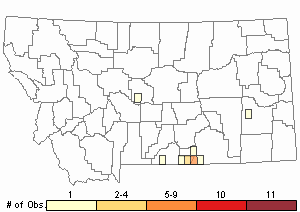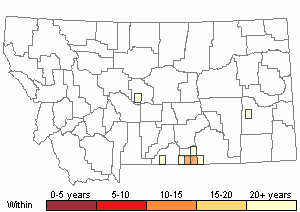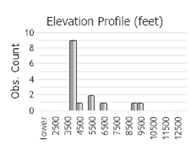View in other NatureServe Network Field Guides
NatureServe
Montana
Utah
Wyoming
Idaho
Wisconsin
British Columbia
South Carolina
Yukon
California
New York
Curved Bladderpod - Physaria curvipes
Other Names:
Lesquerella alpina [in part and misapplied]
State Rank Reason (see State Rank above)
See rank details.
- Details on Status Ranking and Review
Population Size
Score1-2 - Small to Moderate. Population size is imprecisely known but is believed to be >2,000 individuals and <100,000 individuals.
Range Extent
Score2 - Regional or State Endemic or Small Montana Range: Generally restricted to an area <100,000 sq. miles (equivalent to 2/3 the size of Montana or less) or Montana contributes 50% or more of the species’ range or populations OR limited to 2-3 Sub-basins in Montana.
Area of Occupancy
Score2 - Low: Generally occurring in 4-10 Subwatersheds (6th Code HUC’s).
Environmental Specificity
Score1 - Moderate: Species is restricted to a specific habitat that is more widely distributed or to several restricted habitats and is typically dependent upon relatively unaltered, good-quality habitat (C Values of 5-7).
Trends
Score0-1 - Stable to Minor Declines:
Threats
Score0-1 - Low to Medium.
Intrinsic Vulnerability
Score0-1 - Low to Moderate Vulnerability.
Raw Conservation Status Score
Score
6 to 10 total points scored out of a possible 19.
General Description
Stems ascending, 8–24 cm from a simple caudex. Basal leaves spatulate, 25–50 mm long, the blade elliptic to rhombic, entire. Stem leaves spatulate. Vestiture of dense, appressed, 4- to 5-rayed stellate hairs. Petals 4–6 mm long. Fruit ovoid, inflated, 5–9 mm high; style 1.5–2.5 mm long; seeds 2 to 4 per locule; pedicels sigmoid-spreading, 4–7 mm long (
Lesica et al. 2012. Manual of Montana Vascular Plants. BRIT Press. Fort Worth, TX).
Diagnostic Characteristics
Curved Bladderpod -
Physaria curvipes*Pedicels are sigmoid to speading, 4-7 mm long.
*Fruits inflated,
not 2-lobed, ovoid, and 5-9 mm tall. Style is less than half the length of the fruit (silicle).
*Basal leaf blades are thinner than 1 mm.
Thick-leaf Bladderpod –
Physaria pachyphylla, SOC
*Pedicels curve upwards (ascend), 3-10 mm long.
*Fruits inflated,
not 2-lobed, and narrowly elliptic to ovoid, 3-6 mm tall. Style is more than half the length of the fruit (silicle).
*Basal leaves have distinct petioles and blades. Blades are spatulate to oblanceolate in shape, nearly 1 mm thick and cupped (but not folded), and with entire margins [key characteristic].
*Plants grow on pinkish or reddish soils derived from limestone on exposed slopes and ridges in valleys.
Range Comments
Endemic to Big Horn County, MT and adjacent WY (Lesica et al. 2012. Manual of Montana Vascular Plants. BRIT Press. Fort Worth, TX).
Observations in Montana Natural Heritage Program Database
Number of Observations: 19
(Click on the following maps and charts to see full sized version)
Map Help and Descriptions
Relative Density

Recency



 (Observations spanning multiple months or years are excluded from time charts)
(Observations spanning multiple months or years are excluded from time charts)
Habitat
Stony, calcareous soil of exposed slopes, ridges in grassland, open forest; montane to subalpine (
Lesica et al. 2012. Manual of Montana Vascular Plants. BRIT Press. Fort Worth, TX).
Ecological Systems Associated with this Species
References
- Literature Cited AboveLegend:
 View Online Publication
View Online Publication Lesica, P., M.T. Lavin, and P.F. Stickney. 2012. Manual of Montana Vascular Plants. Fort Worth, TX: BRIT Press. viii + 771 p.
Lesica, P., M.T. Lavin, and P.F. Stickney. 2012. Manual of Montana Vascular Plants. Fort Worth, TX: BRIT Press. viii + 771 p.
- Additional ReferencesLegend:
 View Online Publication
View Online Publication
Do you know of a citation we're missing? Grady, B. R., and S. L. O'Kane. 2007. New Species and Combinations in Physaria (Brassicaceae) from Western North America. Novon 17 (2): 182-192.
Grady, B. R., and S. L. O'Kane. 2007. New Species and Combinations in Physaria (Brassicaceae) from Western North America. Novon 17 (2): 182-192. Grady, Benjamin R. 2005. Molecules, morphology, and biogeography: an analysis of the phylogeny and taxonomy of the Physaria reediana species complex (Brassicaceae).
Grady, Benjamin R. 2005. Molecules, morphology, and biogeography: an analysis of the phylogeny and taxonomy of the Physaria reediana species complex (Brassicaceae). Lesica, P., M.T. Lavin, and P.F. Stickney. 2022. Manual of Montana Vascular Plants, Second Edition. Fort Worth, TX: BRIT Press. viii + 779 p.
Lesica, P., M.T. Lavin, and P.F. Stickney. 2022. Manual of Montana Vascular Plants, Second Edition. Fort Worth, TX: BRIT Press. viii + 779 p. Rennick, R.B. 1981. Effects of prescribed burning on mixed prairie vegetation in southeastern Montana. M.Sc. Thesis. Bozeman, MT: Montana State University. 144 p.
Rennick, R.B. 1981. Effects of prescribed burning on mixed prairie vegetation in southeastern Montana. M.Sc. Thesis. Bozeman, MT: Montana State University. 144 p. South, P.R. 1957. Food habits and range use of the mule deer in the Scudder Creek area, Beaverhead County, Montana. M.Sc. Thesis. Bozeman, MT: Montana State University. 34 p.
South, P.R. 1957. Food habits and range use of the mule deer in the Scudder Creek area, Beaverhead County, Montana. M.Sc. Thesis. Bozeman, MT: Montana State University. 34 p. Tschache, O.P. 1970. Effects of ecological changes induced by various sagebrush control techniques on small mammal populations. M.Sc. Thesis. Bozeman, MT: Montana State University. 51 p.
Tschache, O.P. 1970. Effects of ecological changes induced by various sagebrush control techniques on small mammal populations. M.Sc. Thesis. Bozeman, MT: Montana State University. 51 p.
- Web Search Engines for Articles on "Curved Bladderpod"





